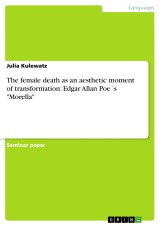Details

The female death as an aesthetic moment of transformation: Edgar Allan Poe´s "Morella"
1. Auflage
|
13,99 € |
|
| Verlag: | Grin Verlag |
| Format: | EPUB, PDF |
| Veröffentl.: | 01.02.2010 |
| ISBN/EAN: | 9783640523504 |
| Sprache: | englisch |
| Anzahl Seiten: | 13 |
Dieses eBook erhalten Sie ohne Kopierschutz.
Beschreibungen
Seminar paper from the year 2009 in the subject Didactics - English - Literature, Works, grade: 1,0, University of Erfurt, course: American Shortstories, BA-Anglistik, language: English, abstract: “The death of a beautiful woman is the really most poetic theme of the world. “
(Edgar Allan Poe)
Edgar Allan Poe was made the way for modern times. Till today his stories constitute as
aesthetic horrible grotesque fascination, in which the death of the beautiful woman is often
put in the centre of attention. When Poe was once confronted with the reproach to write in
the tradition of German Horror‐Stories, he answered rather calmly: “when in many of my
works the horror is the theme, so I argue that these stories did not come from Germany but from
the soul.”
Poe transports the abyss of human subconscious and lets it open a new meta level with the
help of dead female projection surface. Death and dilapidation overshadow not just this
short story, which I am about to analyses in the following explanation.
With “Morella” is Poe able to return suppressed natural needs and instincts in form of a
supernatural ‘You’, which cannot be captured neither by the nameless narrator nor the
reader.
In this Work I will discuss in what extend the female ‘You’ grows into a threat, which
maintains even beyond death. The female death is used in this case as a transformation of
the self and as an aesthetic moment. But the focus is to fathom out male identity with the
help of a fragmentary female identity. Transformation, metamorphosis and doubling are of
major importance for this process.
As a representative of Black Romanticism Poe opens not only the “Night site of romanticism”
for his readers, but also the exemplary illustrates a longing for transcendence in his short
stories. By removing the figure of Morella in exactly this transcendent place, she cannot be
captured by the reader. [...]
(Edgar Allan Poe)
Edgar Allan Poe was made the way for modern times. Till today his stories constitute as
aesthetic horrible grotesque fascination, in which the death of the beautiful woman is often
put in the centre of attention. When Poe was once confronted with the reproach to write in
the tradition of German Horror‐Stories, he answered rather calmly: “when in many of my
works the horror is the theme, so I argue that these stories did not come from Germany but from
the soul.”
Poe transports the abyss of human subconscious and lets it open a new meta level with the
help of dead female projection surface. Death and dilapidation overshadow not just this
short story, which I am about to analyses in the following explanation.
With “Morella” is Poe able to return suppressed natural needs and instincts in form of a
supernatural ‘You’, which cannot be captured neither by the nameless narrator nor the
reader.
In this Work I will discuss in what extend the female ‘You’ grows into a threat, which
maintains even beyond death. The female death is used in this case as a transformation of
the self and as an aesthetic moment. But the focus is to fathom out male identity with the
help of a fragmentary female identity. Transformation, metamorphosis and doubling are of
major importance for this process.
As a representative of Black Romanticism Poe opens not only the “Night site of romanticism”
for his readers, but also the exemplary illustrates a longing for transcendence in his short
stories. By removing the figure of Morella in exactly this transcendent place, she cannot be
captured by the reader. [...]
Diese Produkte könnten Sie auch interessieren:

Berufsorientierung in der Schule - ein Vergleich der Lehrplaninhalte von Wien und Berlin

von: Isabella Löffler

23,00 €















